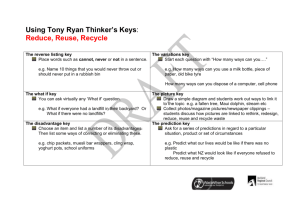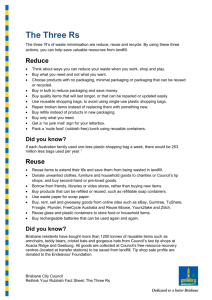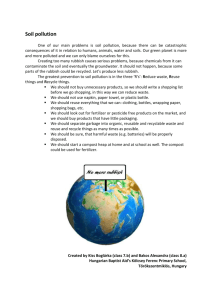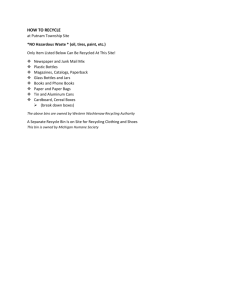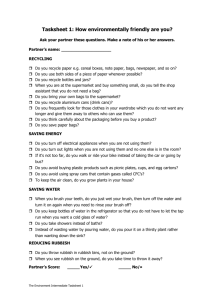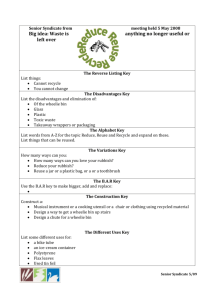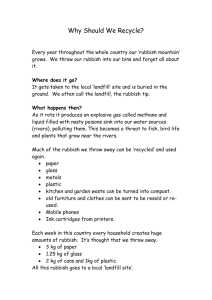Update reduce, reuse, recycle planner 25 sept 09
advertisement
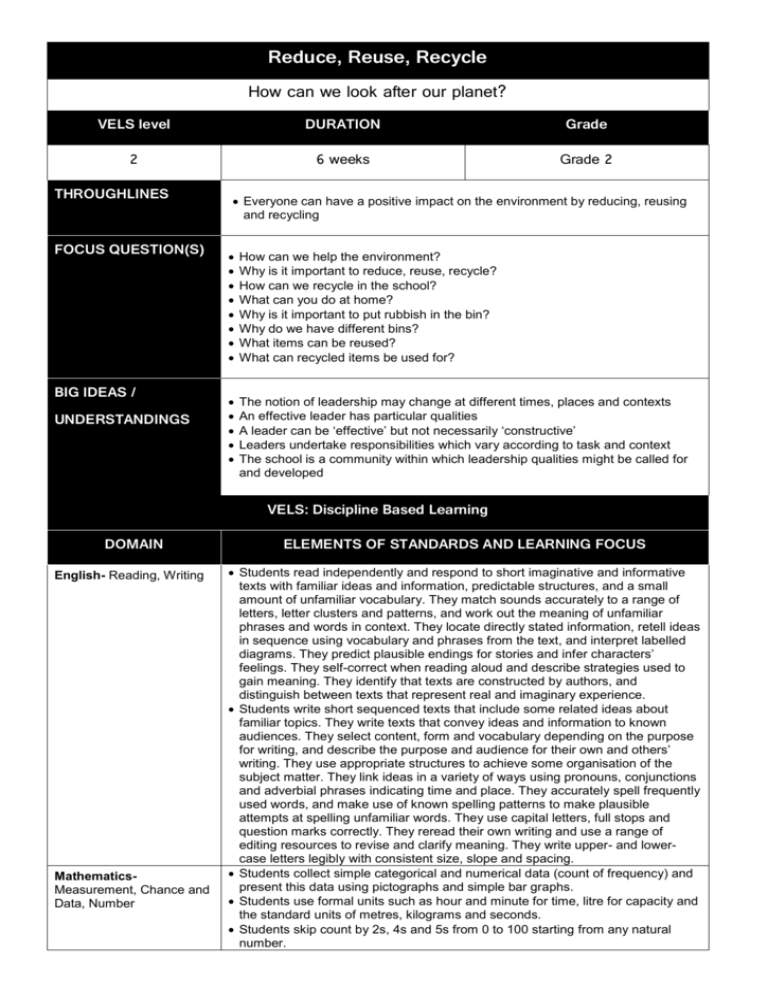
Reduce, Reuse, Recycle How can we look after our planet? VELS level DURATION Grade 2 6 weeks Grade 2 THROUGHLINES FOCUS QUESTION(S) BIG IDEAS / UNDERSTANDINGS Everyone can have a positive impact on the environment by reducing, reusing and recycling How can we help the environment? Why is it important to reduce, reuse, recycle? How can we recycle in the school? What can you do at home? Why is it important to put rubbish in the bin? Why do we have different bins? What items can be reused? What can recycled items be used for? The notion of leadership may change at different times, places and contexts An effective leader has particular qualities A leader can be ‘effective’ but not necessarily ‘constructive’ Leaders undertake responsibilities which vary according to task and context The school is a community within which leadership qualities might be called for and developed VELS: Discipline Based Learning DOMAIN English- Reading, Writing MathematicsMeasurement, Chance and Data, Number ELEMENTS OF STANDARDS AND LEARNING FOCUS Students read independently and respond to short imaginative and informative texts with familiar ideas and information, predictable structures, and a small amount of unfamiliar vocabulary. They match sounds accurately to a range of letters, letter clusters and patterns, and work out the meaning of unfamiliar phrases and words in context. They locate directly stated information, retell ideas in sequence using vocabulary and phrases from the text, and interpret labelled diagrams. They predict plausible endings for stories and infer characters’ feelings. They self-correct when reading aloud and describe strategies used to gain meaning. They identify that texts are constructed by authors, and distinguish between texts that represent real and imaginary experience. Students write short sequenced texts that include some related ideas about familiar topics. They write texts that convey ideas and information to known audiences. They select content, form and vocabulary depending on the purpose for writing, and describe the purpose and audience for their own and others’ writing. They use appropriate structures to achieve some organisation of the subject matter. They link ideas in a variety of ways using pronouns, conjunctions and adverbial phrases indicating time and place. They accurately spell frequently used words, and make use of known spelling patterns to make plausible attempts at spelling unfamiliar words. They use capital letters, full stops and question marks correctly. They reread their own writing and use a range of editing resources to revise and clarify meaning. They write upper- and lowercase letters legibly with consistent size, slope and spacing. Students collect simple categorical and numerical data (count of frequency) and present this data using pictographs and simple bar graphs. Students use formal units such as hour and minute for time, litre for capacity and the standard units of metres, kilograms and seconds. Students skip count by 2s, 4s and 5s from 0 to 100 starting from any natural number. The Arts- Creating and Making Science- Science Knowledge and Understanding Students create and present performing and visual arts works that show emerging arts knowledge and an ability to plan arts works that communicate ideas, concepts, observations feelings and/or experiences. They demonstrate an emerging ability to select, arrange and make choices about expressive ways of using arts elements, principles and/or conventions. They use skills, techniques, processes, media, materials, equipment and technologies in a range of arts forms. They identify, describe and discuss characteristics of their own and others’ arts works. Students begin to generate questions about situations and phenomena, and suggest forms of observations and measurements that are appropriate for the investigation of their questions; for example, 'Which keeps food fresher, paper or plastic?’ and 'What makes sounds change?’ They continue to practise basic procedures and processes, including those involving safety. They investigate ways of reducing waste in their classroom; for example, recycling and composting. VELS: Physical, Personal and Social Learning & Interdisciplinary Learning Civic and Citizenship Civic Knowledge and Understanding Students begin to participate in a range of class and school activities such as recycling, taking responsibility for class resources, and marking local and national celebrations and commemorations. They explore the purpose and benefits of school, community and national events. Students investigate the ways individuals, families, groups and communities can work to improve their environment. Health and Physical educationMovement and Physical Activity As students work towards the achievement of Level 2 standards in the Movement and Physical Activity dimension, they participate in a variety of physical activities in a range of environments (indoor, outdoor and aquatic). They practise basic motor skills such as running and turning. They advance from creating and playing games on their own or with a partner to playing in small and large groups. E5 INSTRUCTIONAL MODEL Learning Goals Ask students to record their learning goals for the inquiry unit in their learning journal. Prior Learning Students are to complete a KWL on Reduce, Reuse, Recycle. What they know? What they would like to know? What they have learnt? (This is completed at the end of the unit) ENGAGE Tuning In Student Questions Ask students to record their questions or wonderings about the inquiry unit in their learning journal or on a wondering wall. English Activity Watch “The Lorax”. Recount what happened in the story. Discuss what is inferred within the story and how this can relate to “real” life. Brainstorm the kinds of words that the students think will be involved in the topic. This will be the start of the students’ topic ‘word wall’, this can be progressively added to as the students’ knowledge develops. Read the book ‘Michael Recycle’ by Ellie Bethel and get the students to develop their own superhero story about being a recycling hero. Mathematics Activity EXPLORE Have students discuss the following questions in small groups or pairs Why do we put rubbish in the bin? Why is it important to make sure our school grounds are clean? How can you make sure people put their rubbish in the bin? When you are in the playground do you always put your rubbish in the bin? Do you think we will find lots of rubbish in the yard? Give the students a map of the school yard. On this map the bins are also outlined. Tell the students that in the same small groups or pairs they are going to map 6 or 7 pieces of rubbish. They will need to measure using their feet. Heel to toe how far away the rubbish is from a bin. After they measure how far away the rubbish is from the bin, they then mark it on their map. After noting the position of the rubbish they can dispose of it in the appropriate bin. Creating and Exploring Finding Out The Arts Making a drum recycled materials In art class students can decorate old cans using paint, paper, glitter or anything they like. They then paint greaseproof paper with PVA. They put that on the top of their can to make a drum. The drum must be left to dry over night before it is used. This is to demonstrate to the students that recycled goods can be used in many different ways to make useful new things. Processing Information Mathematics EXPLAIN Sorting Out Teacher will bring in rubbish for the students to graph. There will be different bins out the front of the room, paper and cardboard, plastics, non recyclable, glass and metal. The students will come and take a piece of rubbish from the bag and put it in the corresponding labelled box. They will then stand behind the box forming a line. The students will then be building a visual graph. After this they will record the data just gathered and they will create their own bar or column graph. Focused Learning Health and Physical education Students have a PE lesson where they will take the rubbish that was just used in their graphing lesson and have a ‘rubbish relay’. Teams form at one end of the relay track, bins for recyclable and non-recyclable items are placed at the opposite end. In teams they must pick up one item of rubbish and run to deposit it in the correct bin. In this activity, it isn’t necessarily the quickest teams that win but the team which has the greatest understanding of recycling categories. Generalising Understanding The Arts ELABORATE Going Further As a class students will cut up newspapers, magazines and make a recycled envelope and paper. They can use any reusable material to make their writing set. Apply and Transfer English Students then write a letter to their parents about how they can recycle at home. This letter will use information gathered from all prior lessons. Once a draft is complete the student can then write their letters on their paper which they had made earlier and send their letter in the mail. Student Reflection Students complete their KWL about what they have learnt during the unit on reducing, reusing and recycling. Performances of Understanding English / Mathematics / The Arts / Science EVALUATE Making Conclusions Taking Action Read the book ‘Look After Your Planet’ by Lauren Child. This book talks about creating a recycling progress tree. This is a picture of a tree which has empty spaces for leaves. The students need to make leaves which they can stick onto their tree. Everyday the students need to work out what in their lunch can be recycled and put it in the appropriate bin. At the end of each day the teacher counts how many recyclable items have been put into the bins. Then that amount of leaves can be added to the tree. Once all the empty leaves on the ‘progress tree’ are full the students can then plant a real tree in the school environment. If the students enjoy this activity you can keep making more and more trees. The activity doesn’t need to finish after one tree is planted. Monitoring and Tracking Mathematics / Science / Civics and Citizenship Student can then start a monitoring and tracking class recycling program. On a daily basis students can weigh and graph their recyclable and non recyclable items within their classroom. Their intention is to have more rubbish that is recyclable than rubbish that is non recyclable. This will also demonstrate to the class that they can make a difference to their environment through reducing, reusing and recycling. RESOURCES Some useful websites: www.kidsplanet.org – Kids Planet www.kidsface.org/ - Kids For A Clean Environment www.ecokidsonline.com/pub/ecomentors/index.cfm - Eco Mentors www.captainplanetfdn.org/index.html - Captain Planet Foundation http://kids.nationalgeographic.co.uk/ - National Geographic Kids www.meetthegreens.org/ - Meet the Greens www.childrenoftheearth.org – Children of the Earth www.dnr.state.wi.us/org/caer/ce/eek/index.htm - Environmental Education For Kids Some useful books: What A Load Of Rubbish: Rescue Your Household Waste. (1990) By Steve Skidmore. Gorgeous Gifts. (2007) By Rebecca Craig. Stop Water Waste. (2003) By Claire Llewell. Recycled Water. (2006) By Michael and Jane Pelusey. What’s It Made Of?: Early stages. (2008) Australian Government. Don’t Throw It Away. (1991) By Brian Knapp. Michael Recycle. (2008) By Elli Bethel. Look After Your Planet. (2008) By Lauren Child. Recycle, Reduce, Reuse, Rethink: Glass. (2004) By Kate Walker. Recycle, Reduce, Reuse, Rethink: Aluminium. (2004) By Kate Walker. Recycle, Reduce, Reuse, Rethink: Plastic. (2004) By Kate Walker. Recycle, Reduce, Reuse, Rethink: Paper. (2004) By Kate Walker. Recycle, Reduce, Reuse, Rethink: Household Waste. (2004) By Kate Walker. Recycle, Reduce, Reuse, Rethink. (2007) By Kate Walker. Save Our Earth. (1991) By Ron Bacon. Evaluation of Unit Checklist POLT Principle 1: Supportive and productive learning environment: 1.1 builds positive relationships with & between students 1.2 promotes a culture of value and respect 1.3 uses strategies that promote students' self-confidence and willingness to take risks 1.4 each student experiences success with support Principle 2: The learning environment promotes independence, interdependence and self motivation: 2.1 encourages and supports students to take responsibility for their learning 2.2 uses strategies that build skills of productive collaboration Principle 3: Students' needs, backgrounds, perspectives and interests are reflected in the learning program: 3.1 uses flexible strategies that are responsive to the values, needs and interests of individuals 3.2 strategies support different ways of thinking & learning 3.3 builds on students' prior experiences, knowledge and skills 3.4 capitalises on experiences of a technology rich world. Principle 4: Students are challenged and supported to develop deep levels of thinking and application: 4.1 plans sequenced activities that emphasise connections 4.2 promotes substantive discussion of ideas 4.3 emphasises high expectations of achievement 4.4 strategies challenge/support students to question & reflect 4.5 strategies to develop investigating and problem solving skils 4.6 uses strategies to foster imagination and creativity. Principle 5: Assessment practices are an integral part of teaching and learning: 5.1 designs assessment practices that reflect the full range of learning program objectives 5.2 ensures that students receive frequent constructive feedback that supports further learning 5.3 makes assessment criteria explicit 5.4 uses assessment practices that encourage reflection and self assessment 5.5 uses evidence from assessment to inform planning and teaching. Principle 6: Learning connects with communities: 6.1 students engage with contemporary knowledge & practice 6.2 students to interact with local and broader communities 6.3 use technologies to reflect professional and community practices. This example of an E5 Unit plan was compiled by Cindi Bruechert. Ideas for this unit were sourced from the following website: http://www.education.tas.gov.au/mediacollection/ltag_resources/the_leading_edge
